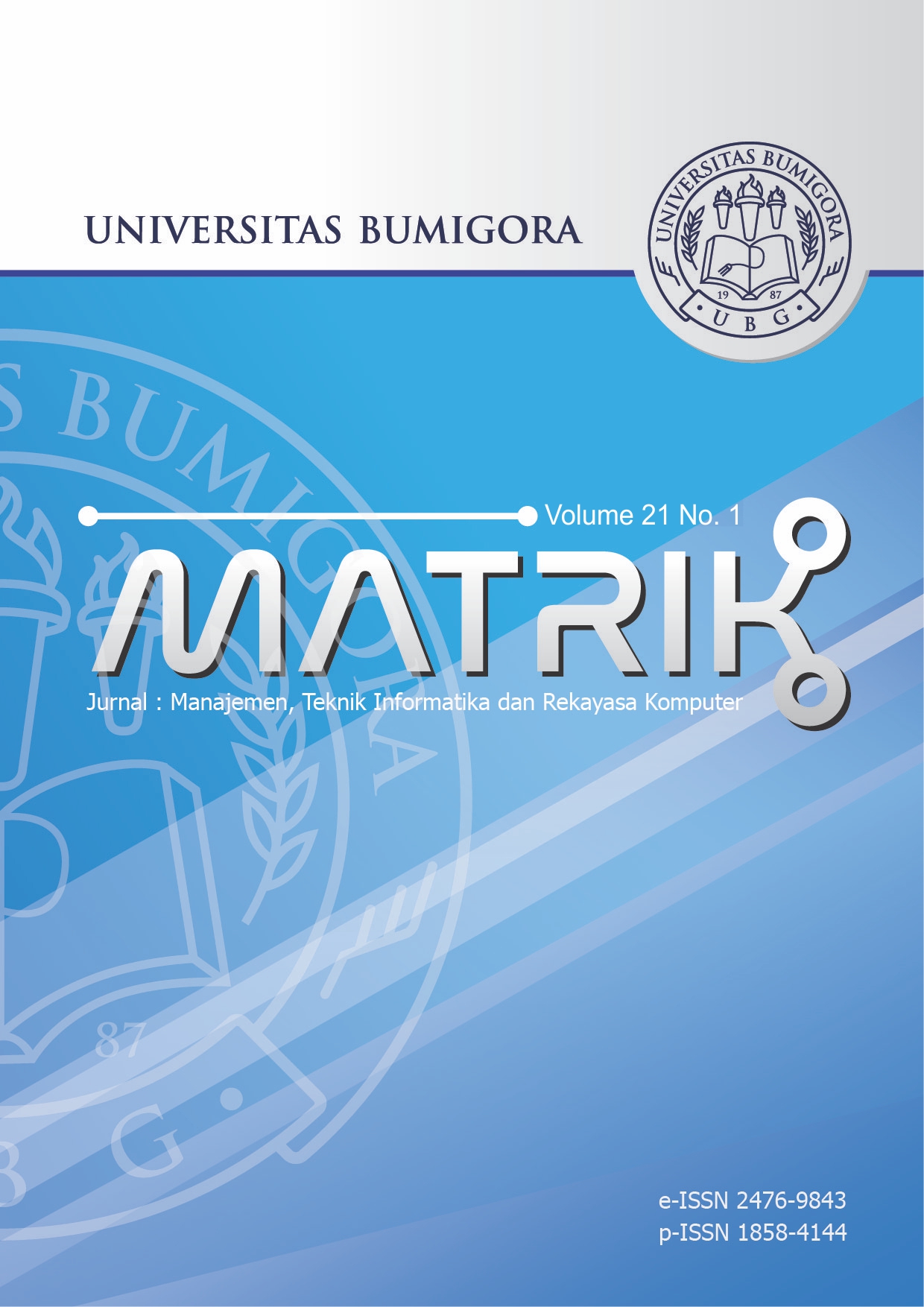Low Cost System for Face Mask Detection Based Haar Cascade Classifier Method
DOI:
https://doi.org/10.30812/matrik.v21i1.1187Keywords:
Low cost system, Face mask detection, Haar like features, COVID-19Abstract
In December 2019, there was a pandemic caused by a new type of coronavirus, namely SARS-CoV-2 (Severe Acute Respiratory Syndrome Corona Virus 2) spread almost throughout the world. The World Health Organization (WHO) named it COVID-19 (Coronavirus Disease). To minimize the spread of the COVID-19, the Indonesian government announced a policy for the social distancing of 1-2 meters and wearing a medical mask. In this study, a mask detection system was built using the Haar Cascade Classifier method by detecting the facial areas such as the nose and lips. The study aims to distinguish between using masks and on the contrary. It is expected that the mask detection system can be implemented to provide direct warnings to people who do not wear masks in public areas. The results using the Haar Cascade Classifier method show that the system designed is able to detect faces, noses, and lips at a light intensity of 80-140 lux. The face is detected at a distance of 30-120cm, while the nose is at a distance of 30-60cm, while the lips are at a distance of 30-70cm. The system designed can perform the detection process at a speed of 5 fps. The overall test results obtained a success rate of 88,89%.
Downloads
References
[2] W. Director-General, “WHO Director-General’s remarks at the media briefing on 2019-nCoV on 11 February 2020,†World Health Orgnatization (WHO), 2020. https://www.who.int/dg/speeches/detail/who-director-general-s-remarks-at-the-media-briefing-on-2019-ncov-on-11-february-2020 (accessed Jul. 27, 2020).
[3] W. Director-General, “Coronavirus disease 2019 ( COVID-19 ),†World Health Orgnatization (WHO). https://www.who.int/docs/default-source/coronaviruse/situation-reports/20200423-sitrep-94-covid-19.pdf (accessed Jul. 27, 2020).
[4] S. Annas, M. Isbar Pratama, M. Rifandi, W. Sanusi, and S. Side, “Stability analysis and numerical simulation of SEIR model for pandemic COVID-19 spread in Indonesia,†Chaos, Solitons and Fractals, vol. 139, pp. 1–7, 2020, doi: 10.1016/j.chaos.2020.110072.
[5] K. Kesehatan, “Tanya Jawab Novel Coronavirus (2019-nCoV),†https://covid19.kemkes.go.id, 2020. https://covid19.kemkes.go.id/situasi-infeksi-emerging/info-corona-virus/tanya-jawab-novel-coronavirus-2019-ncov-faq-update-4-februari-2020/#.X4VG-WgzZPZ (accessed Feb. 04, 2020).
[6] R. V. Manigandan S, Wu M-Tsang, Ponnusamy VK and A. Pugazhendhi A, Brindhadevi K, “A systematic review on recent trends in transmission, diagnosis, prevention and imaging features of COVID-19,†Process Biochemistry, pp. 1–27, 2020, doi: 10.1016/j.procbio.2020.08.016.
[7] W. Lyu and G. L. Wehby, “Community Use Of Face Masks And COVID-19: Evidence From A Natural Experiment Of State Mandates In The US,†Health affairs (Project Hope), vol. 39, no. 8, pp. 1419–1425, 2020, doi: 10.1377/hlthaff.2020.00818.
[8] S. Feng, C. Shen, N. Xia, W. Song, M. Fan, and B. J. Cowling, “Rational use of face masks in the COVID-19 pandemic,†The Lancet Respiratory Medicine, vol. 8, no. 5, pp. 434–436, 2020, doi: 10.1016/S2213-2600(20)30134-X.
[9] D. K. Chu et al., “Physical distancing, face masks, and eye protection to prevent person-to-person transmission of SARS-CoV-2 and COVID-19: a systematic review and meta-analysis,†The Lancet, vol. 395, no. 10242, pp. 1973–1987, 2020, doi: 10.1016/S0140-6736(20)31142-9.
[10] M. M. Lambacing and Ferdiansyah, “Rancang Bangun New Normal Covid-19 Masker Detektor Dengan Notifikasi Telegram Berbasis Internet of Things,†Jurnal Dinamik, vol. 25, no. 2, pp. 77–84, 2020, doi: 10.35315/dinamik.v25i2.8070.
[11] G. Saranya, D. Sarkar, S. Ghosh, L. Basu, K. Kumaran, and N. Ananthi, “Face Mask Detection using Jetson Nano,†International Research Journal of Modernization in Engineering Technology and Science, vol. 03, no. 09, pp. 702–706, 2021, doi: 10.1109/csnt51715.2021.9509556.
[12] M. D. Putro, D. L. Nguyen, and K. H. Jo, Real-Time Multi-view Face Mask Detector on Edge Device for Supporting Service Robots in the COVID-19 Pandemic, vol. 12672 LNAI, no. April. Springer International Publishing, 2021.
[13] S. R. Reza, X. Dong, and L. Qian, “Robust Face Mask Detection using Deep Learning on IoT Devices,†IEEE International Conference on Communications Workshops (ICC Workshops), 2021, [Online]. Available: https://ieeexplore.ieee.org/document/9473701.
[14] N. S. Luthfie, “Implementasi Jaringan Saraf Tiruan Backpropagation pada Aplikasi Pengenalan Wajah Dengan Jarak Yang Berbeda Menggunakan MATLAB 7.0,†Informatika, Jurusan Teknik Gunadarma, Universitas, pp. 1–7, 2007.
[15] S. Al-Aidid and D. Pamungkas, “Sistem Pengenalan Wajah dengan Algoritma Haar Cascade dan Local Binary Pattern Histogram,†Jurnal Rekayasa Elektrika, vol. 14, no. 1, pp. 62–67, 2018, doi: 10.17529/jre.v14i1.9799.
[16] P. Choirina and R. A. Asmara, “Deteksi Jenis Kelamin Berdasarkan Citra Wajah Jarak Jauh Dengan Metode Haar Cascade Classifier,†Jurnal Informatika Polinema, vol. 2, no. 4, p. 164, 2016, doi: 10.33795/jip.v2i4.77.
[17] W. Sulistiyo, B. Suyanto, I. Hestiningsih, Mardiono, and Sukamto, “Rancang Bangun Prototipe Aplikasi Pengenalan Wajah untuk Sistem Absensi Alternatif dengan Metode Haar Like Feature dan Eigenface,†Journal of Technical Education and Training (JTET), vol. 3, no. 2, pp. 93–98, 2014, [Online]. Available: https://jurnal.polines.ac.id/index.php/jtet/article/view/180/172.
[18] R. Prathivi and Y. Kurniawati, “Sistem Presensi Kelas Menggunakan Pengenalan Wajah Dengan Metode Haar Cascade Classifier,†Simetris: Jurnal Teknik Mesin, Elektro dan Ilmu Komputer, vol. 11, no. 1, pp. 135–142, 2020, doi: 10.24176/simet.v11i1.3754.
[19] V. K and S.Padmavathi, “Facial Parts Detection Using Viola Jones Algorithm,†International Conference on Advanced Computing and Communication Systems (ICACCS -2015), pp. 1–4, 2017.
[20] Raspberry Pi Foundation, “Camera Module,†in Product Data, 2016, p. 1.
[21] RaspberryPi, “Raspberry Pi 3 Model B+ Datasheet,†Datasheet, p. 5, 2016, [Online]. Available: https://static.raspberrypi.org/files/product-briefs/Raspberry-Pi-Model-Bplus-Product-Brief.pdf.
[22] M. L. R. Chandra, B. V. Kumar, and B. Sureshbabu, “IoT enabled home with smart security,†2017 International Conference on Energy, Communication, Data Analytics and Soft Computing, ICECDS 2017, pp. 1193–1197, 2018, doi: 10.1109/ICECDS.2017.8389630.
[23] I. Imanuddin, F. Alhadi, R. Oktafian, and A. Ihsan, “Deteksi Mata Mengantuk pada Pengemudi Mobil Menggunakan Metode Viola Jones,†MATRIK : Jurnal Manajemen, Teknik Informatika dan Rekayasa Komputer, vol. 18, no. 2, pp. 321–329, 2019, doi: 10.30812/matrik.v18i2.389.
[24] S. Chau, J. Banjarnahor, D. Irfansyah, and S. Kumala, “Analisis Pendeteksian Pola Wajah Menggunakan Metode Haar-Like Feature,†Journal of Informatics and Telecommunication Engineering, vol. 2, no. 2, p. 69, 2019, doi: 10.31289/jite.v2i2.2133.
Downloads
Published
Issue
Section
How to Cite
Similar Articles
- Imanuddin Imanuddin, Fachrid Alhadi, Raza Oktafian, Ahmad Ihsan, Deteksi Mata Mengantuk pada Pengemudi Mobil Menggunakan Metode Viola Jones , MATRIK : Jurnal Manajemen, Teknik Informatika dan Rekayasa Komputer: Vol. 18 No. 2 (2019)
- Yuri Ariyanto, Yan Watequlis Syaifudin, M. Hasyim Ratsanjani, Ali Ridho Muladawila, Triana Fatmawati, Pramana Yoga Saputra, Chandrasena Setiadi , Cyber Threat Detection and Automated Response Using Wazuh and Telegram API , MATRIK : Jurnal Manajemen, Teknik Informatika dan Rekayasa Komputer: Vol. 25 No. 1 (2025)
- Andi Hary Akbar, Heri Wijayanto, I Wayan Agus Arimbawa, K-Means-Based Customer Segmentation with Domain-Specific Feature Engineering for Water Payment Arrears Management , MATRIK : Jurnal Manajemen, Teknik Informatika dan Rekayasa Komputer: Vol. 25 No. 1 (2025)
- Bob Subhan Riza, Jufriadif Na'am, Sumijan Sumijan, Tuberculosis Extra Pulmonary Bacilli Detection System Based on Ziehl Neelsen Images with Segmentation , MATRIK : Jurnal Manajemen, Teknik Informatika dan Rekayasa Komputer: Vol. 22 No. 1 (2022)
- Bambang Krismono Triwijoyo, SEGMENTASI CITRA PEMBULUH DARAH RETINA MENGGUNAKAN METODE DETEKSI GARIS MULTI SKALA , MATRIK : Jurnal Manajemen, Teknik Informatika dan Rekayasa Komputer: Vol. 15 No. 1 (2015)
- Nella Rosa Sudianjaya, Chastine Fatichah, Segmentation and Classification of Breast Cancer Histopathological Image Utilizing U-Net and Transfer Learning ResNet50 , MATRIK : Jurnal Manajemen, Teknik Informatika dan Rekayasa Komputer: Vol. 24 No. 1 (2024)
- Sela Octaviani, Evi Triandini, Dandy Pramana Hostiadi, Evaluating Lecturer Satisfaction on Academic Information System Using Usability and EUCS at Bandung University of Technology , MATRIK : Jurnal Manajemen, Teknik Informatika dan Rekayasa Komputer: Vol. 25 No. 1 (2025)
- Ni Wayan Sumartini Saraswati, I Wayan Agustya Saputra, Sistem Monitoring Tekanan Air pada PDAM Gianyar Berbasis Web , MATRIK : Jurnal Manajemen, Teknik Informatika dan Rekayasa Komputer: Vol. 18 No. 2 (2019)
- Purnawarman Musa, Eri Prasetyo Wibowo, Saiful Bahri Musa, Iqbal Baihaqi, Pelican Crossing System for Control a Green Man Light with Predicted Age , MATRIK : Jurnal Manajemen, Teknik Informatika dan Rekayasa Komputer: Vol. 21 No. 2 (2022)
- Ni Gusti Ayu Dasriani, Sirojul Hadi, Moch Syahrir, Intelligent System for Internet of Things-Based Building Fire Safety with Naive Bayes Algorithm , MATRIK : Jurnal Manajemen, Teknik Informatika dan Rekayasa Komputer: Vol. 23 No. 1 (2023)
You may also start an advanced similarity search for this article.
Most read articles by the same author(s)
- Sirojul Hadi, Puspita Dewi, Radimas Putra Muhammad Davi Labib, Parama Diptya Widayaka, Sistem Rumah Pintar Menggunakan Google Assistant dan Blynk Berbasis Internet of Things , MATRIK : Jurnal Manajemen, Teknik Informatika dan Rekayasa Komputer: Vol. 21 No. 3 (2022)
- Ni Gusti Ayu Dasriani, Sirojul Hadi, Moch Syahrir, Intelligent System for Internet of Things-Based Building Fire Safety with Naive Bayes Algorithm , MATRIK : Jurnal Manajemen, Teknik Informatika dan Rekayasa Komputer: Vol. 23 No. 1 (2023)


.png)












